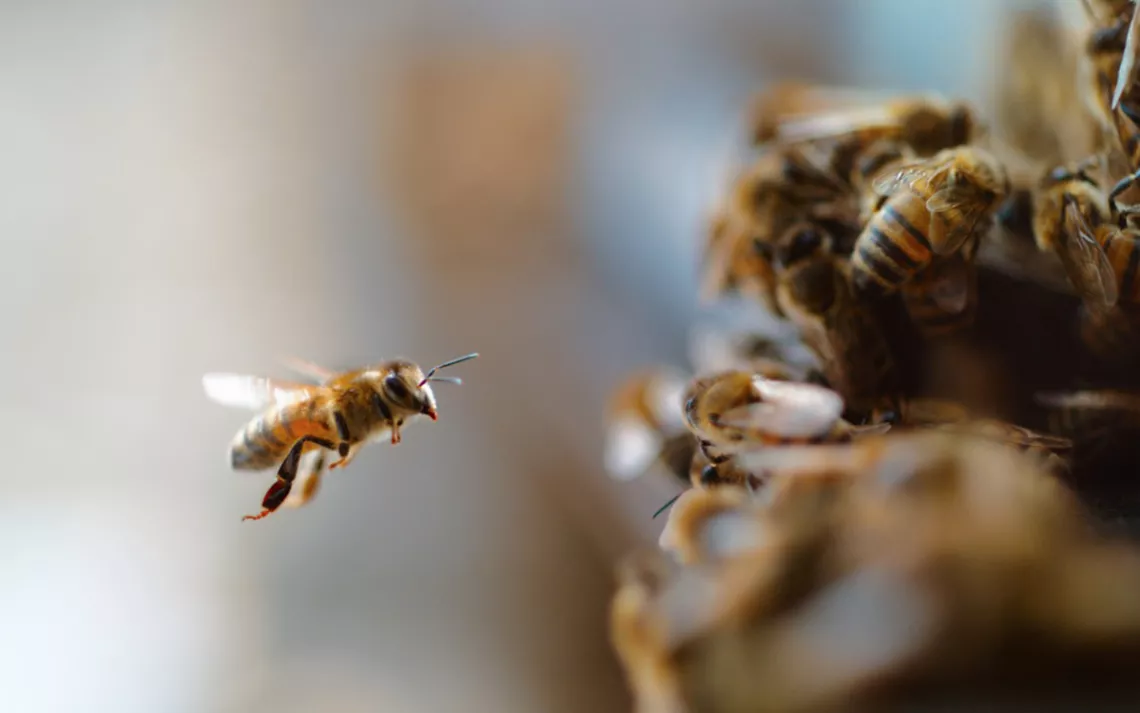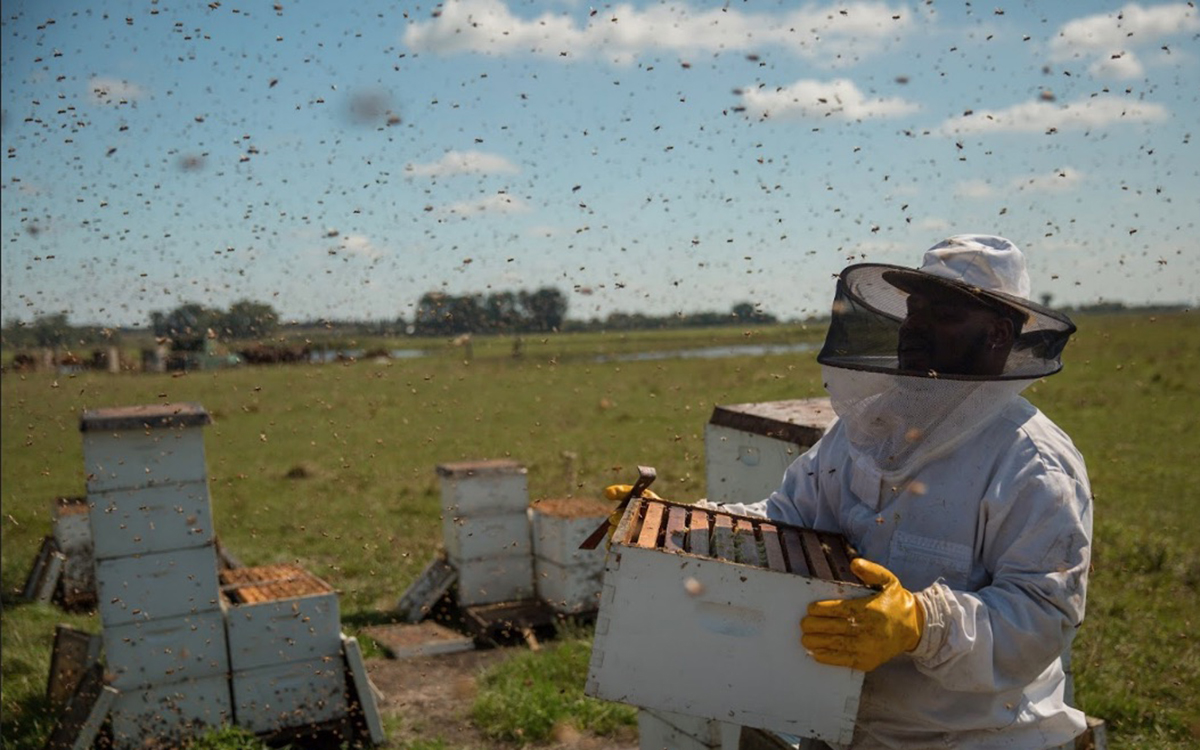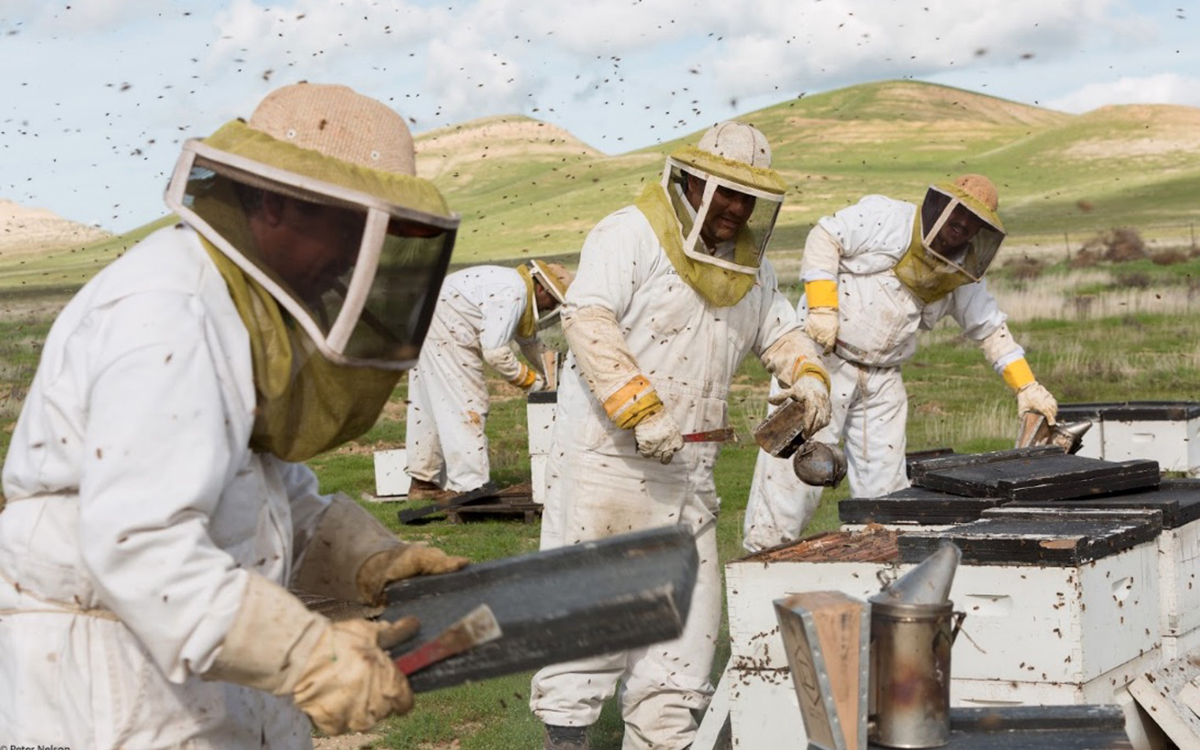One-Third of Our Food Supply Relies on a Very Sick Species: Honeybees
"The Pollinators" highlights problems for the managed honeybee

Stills from Peter Nelson's The Pollinators | Photos courtesy of Peter Nelson
The Pollinators opens under a predawn thread of red light along a highway near California’s almond orchards. Hundreds of wooden boxes, stacked like dresser drawers on the back of tractor trailers, are surrounded by a soft veil of honeybees. Bob Harvey, a beekeeper at Bob’s Bees, estimates 18,000 honeybee hives or 40 truckloads will arrive that day. Our food economy, at least $20 billion of it, relies on the movement of the managed honeybee—a domesticated import from Europe—pollinating about one-third of our entire food supply.
From the almond groves of the west to the apple orchards of Pennsylvania and the blueberry fields of eastern Canada, honeybees are shipped around the nation based on bloom time. The migration happens at night, after the bees tuck into their pale blue and white boxes for the evening. California has well over a million acres in almonds. Dave Hackenberg, of Hackenberg Apiaries, says to pollinate this area during the winter bloom requires nearly all of the US honeybee supply.
“Chemical companies figure we should eat corn, soybeans, and rice,” says Davey Hackenberg, a beekeeper at Hackenberg Apiaries, “and those don’t need to be pollinated, and that’s what they think we ought to live on. But if you like your fruits, your vegetables, your nuts, a lot of that stuff needs to be pollinated.”
Farming’s reliance on the managed honeybee is a growing problem as the honeybee population continues to decline. Samuel Ramsey, an entomologist at the University of Maryland, College Park, estimates 33 to 50 percent of all honeybee colonies in the United States are dying every year. The population is only held steady by splitting colonies. But Ramsey is clear: This method isn’t sustainable. Splitting honeybee hives is triage. It’s not a long-term solution.


While theories around honeybee losses used to focus on colony collapse disorder—worker bees abandoning their hives—the film, and the EPA, say this is no longer the major cause of hive losses. Instead, a trifecta of problems is leading to honeybee losses: pesticides, parasites, and poor nutrition. Ramsey says honeybees could deal with one issue, but not all three at once.
In 1996, Congress passed the Food Quality Protection Act, reevaluating the use of pesticides that poisoned farmworkers. But instead of removing pesticides from agricultural use altogether, the chemical compositions were simply replaced. Neonicotinoids, first registered in 1994, rose in use, and according to organic chemist and farmer Susan Kegley, these chemicals are “everywhere now.” They’re so deadly to bees, in 2016, the US Fish and Wildlife stopped using them on national wildlife refuges, and in the European Union, certain varieties of neonicotinoids are illegal to use on bee-attractive crops. The chemicals take years to degrade in the environment—even untreated plants can absorb the chemicals from soils treated the year before—and they continue to poison bees long after application.
In the film, which screened at the recent San Francisco Green Film Festival, Bret Adee of Adee Honey Farms receives a call that a bee kill is happening at his hives in an almond grove. When he arrives, thousands of bees are piled like rugs at the edge of their hives. He suspects someone sprayed a pesticide, but he says these things are hard to track. “If we put the same economic value on a honeybee as cattle, we wouldn’t have a pesticide investigator out here for these kinds of losses,” Adee says. “We’d have the FBI out here.” Alongside pesticides, there are parasites, particularly the invasive varroa mite. This vampiric pest sucks the blood of honeybees, severely weakening them and shortening their life. Ramsey calls the mite “public enemy number one.”
The most widespread culprit in the death of the pollinators might be the poor nutrition that stems from industrialized agriculture. Large-scale cattle and corn operations create food deserts for pollinators. Without moving managed honeybees after bloom time, they’d be in a land of pesticides and densely populated crops that no longer require pollination. After bemoaning the loss of agricultural diversity and resiliency, the film also points to some solutions within industrial agriculture. Two farmers at Criswell Acres, while still growing commodity crops like corn, soy, and small grains, do so while incorporating more sustainable farming practices. They plant cover crops, providing forage for native pollinators, and they limit their tillage, building healthier soils less dependent on chemical additives. They’ve cut down on pesticide use, even though most of their crops are self-pollinating and therefore don’t require native pollinators. The farmers describe themselves as part of an ecological system.
The_Pollinators_Trailer_1080 from Peter Nelson on Vimeo.
The film only briefly touches on native pollinators. Kegley says that native pollinators—like bees, butterflies, hummingbirds, moths, and beetles—are no longer around in large enough quantities to do the pollination necessary for huge agricultural fields. While honeybees have human-powered migration, native pollinators can’t move away as quickly after farm fields pillage their habitat corridors. According to the film, the decline of native pollinators isn’t monitored to the same extent, and doesn’t receive the same media attention, as the decline of the managed honeybee—likely because, unlike native pollinators, honeybees are an income stream.
The movie points fingers in sometimes unflattering ways. The chef of an organic farm just outside New York City blames the consumers for our current food system, calling it “a reflection of us.” A loss in seasonality and imperfect fruits and vegetables mean consumers expect unblemished produce, and they expect it year-round. In order to provide these fruits, producers are dependent on chemicals. But this doesn’t highlight the influence of big seed, chemical, and energy businesses whose pocketbooks are lined by the industrialized food system. Do individual, consumer-conscious choices matter? Of course. But it’s not the reason corn covers 5 percent of all terrestrial land in the world.
It harkens back to debates circling climate change: Should we use plastic straws? What burgers should we consume? What cars should we drive? These questions are important. But as Elizabeth Warren pointed out during 2019’s climate town hall, they’re not striking at the heart of the problem: how corporations control the narrative of our food and energy systems. When the film focuses on industrialized agriculture and how it’s impacting all native pollinators, it really buzzes.
 The Magazine of The Sierra Club
The Magazine of The Sierra Club







